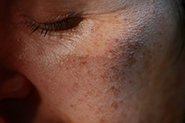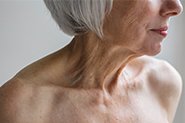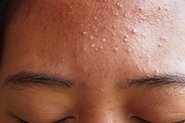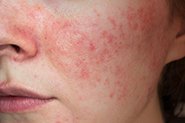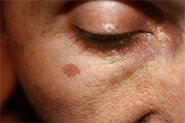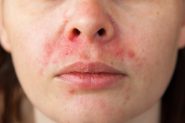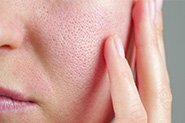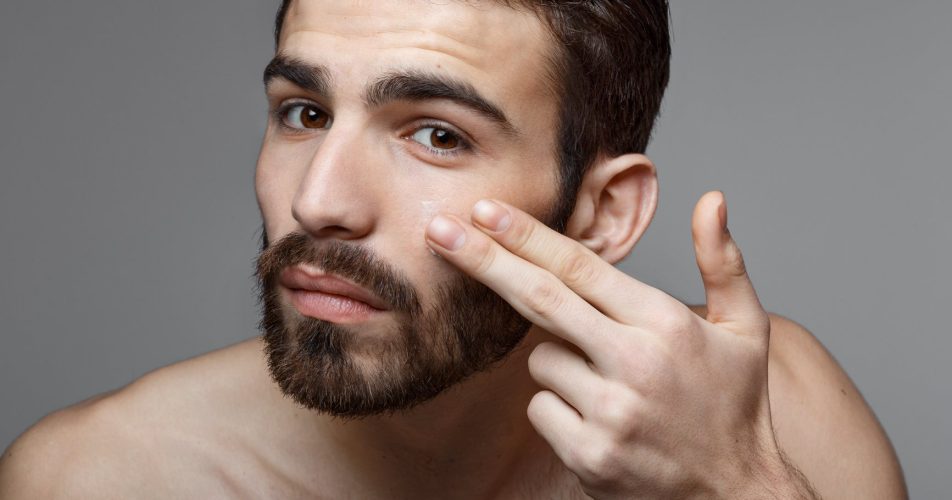
Skincare for men is having a MOMENT. But is there really enough difference between male and female skin for men to warrant different or mens-only skincare products (or whole men’s skincare lines)?
In this article, we break down the science of how sex affects the skin’s anatomy and physiology so you can separate marketing from fact (and understand what the best men’s skincare really is!).
Let’s start with sebum (oil) production
One study measured the difference in facial sebum production (forehead and cheeks) between the sexes using a device called a sebumeter [1]. They found that there wasn’t a significant difference in sebum production between men and women in younger years. After age 50 this changes, with sebum production in women progressively decreasing with age. It’s thought that is due to hormonal changes associated with menopause.
Several other studies showed similar findings [2,3].
Interestingly, there is a large variation WITHIN each age group. This means there are differences in sebum production between individuals, regardless of sex. The most likely explanation for this is differences in lifestyle factors, such as using (or not using!) a daily skincare routine. This means that choosing skincare products based on your own personal preferences (e.g. lighter formulations if your skin is oilier) is more important than choosing products designed just for ‘male’ or ‘female’ skin.
What about skin elasticity?
Skin is elastic: when you stretch and release it, it goes back to its original position. At least until about age 30 onwards, when chronic sun exposure degrades the elastic fibres in the skin of both sexes – leading to wrinkling and sagging skin in sun-exposed areas ☀️
So, are there any differences in elasticity between elasticity in male vs female skin?
The short answer is no. Multiple studies [4-9] have investigated this using a nifty device called a cutometer. It stretches skin by sucking it up into a tiny hole, then measures how well it rebounds to its original position.
In every one of these studies, there was no significant difference between skin elasticity in male vs female test subjects, although the decline with age was significant in both sexes.
The take home message about elasticity? Sun protection is a vital part of a daily skincare routine for everyone. If you only use 1 product, make it sunscreen (the creamy ones double as a moisturiser!)
Skin thickness
This is where things start to get interesting because different techniques were used to measure different things…
One study [10] looked at thickness of the dermal layer as well as collagen density in men and women. They found that dermal collagen in males starts to reduce from age 20 onwards, with gradual reduction in skin thickness. Women’s skin was thinner overall but statistical testing was not performed to determine if this was actually the case. Collagen degradation (and dermal thinning) did sharply increase in women after age 50 however (thanks hormones 😒).
A second study [11] looked only at the epidermis, and found no difference in skin thickness between the sexes. Another study [11] found similar results using the same technique, but noted that forehead thickness was significantly thinner in older women vs men.
So, although there is inconsistency in these results due to experimental differences, it seems that the common belief that men have ‘thicker’ skin than women isn’t supported by solid scientific evidence (at least until women reach peri/post-menopause).
Preventing collagen break down at all life stages is clearly an issue for both sexes however! And we know that the gold-standard topical treatment for this (no matter your age or sex) is prescription retinoids + sunscreen.
Hydration, skin barrier function, skin surface pH, facial wrinkling
Let’s wrap up the science of mens skincare by looking at a range of studies investigating other skin parameters in men vs women [12].
There is no consistency between the findings in any of these studies – in fact, they directly contradict each other. So the more likely explanation for any differences is varying devices used to do the measuring, how well the study was designed, where on the body the measurement was taken, the age of the test subjects, whether they had a consistent and basic skincare routine, their ethnic background, existing skin conditions, occupation, smoking history, sun protection behaviours (especially sunscreen use), and diet.
So, is men’s skin really any different to women’s? And do men need skincare?
There just isn’t enough measurable or significant difference between male & female skin biology, and certainly not enough to warrant the need for separate skincare ranges.
But men need skincare just as much as women! Got skin? You need some form of skincare! And if you’re in Australia, the best mens skincare will always involve sunscreen at the very least.
So what is the best skincare for men in Australia? Well, that’s easy: its the same as the best skincare for women! Just treat the skin you have, in the condition it’s in, and with your budget and personal preferences in mind – not whether you identify as male or female. A simple, evidence-based routine of cleanser, moisturiser, prescription retinol and sunscreen is appropriate for men and women.
Why do gendered skincare products exist?
The answer is marketing – and it’s not limited to skincare.
Wander down the supermarket aisles and you will notice most deodorants, razors, hygiene and hair products are marketed as either his OR hers. Even though, on an ingredient level, most gendered products are almost identical (some are actually identical!), albeit with different packaging, fragrance and/or colour. If you’re someone who prefers ‘feminine’ gendered products, these often come with a higher price tag (something called the pink tax). This kind of marketing also excludes anyone who doesn’t identify as either of the binary sexes.
It’s easy to see why this happens. Lots of people enjoy engaging in skincare and beauty rituals (our experience is that men can be just as skincare obsessed as women, and women often prefer a few simple, fragrance-free multitasking products to the complicated routines that are more traditionally ‘female’). In a world flooded with skincare and beauty products, and consumer demand for skincare constantly increasing, changing up the packaging and marketing the same or almost identical product to a different demographic (often the partners of your existing customers), whilst telling men they need this because their skin is ‘different’, represents an easy sales opportunity.
Gender-based skincare marketing is tired and without any basis in science. People shouldn’t be made to feel uncomfortable because they enjoy a certain packaging or fragrance, or prefer a multi-step skincare routine to a simple one. Nor should they be made to pay more for their choices.
At Qr8 MediSkin, our belief is that skincare is genderless – everyone can and should use a cleanser, moisturiser, prescription retinol, and sunscreen, regardless of how they identify, their skin type or age.
We don’t have male or female prescription skin treatments because our products are drugs – and you don’t find gendered versions of medicines! We just treat the skin you’re in, in the condition it’s in, using evidence-based ingredients, and with your personal preferences in mind.
At Qr8 MediSkin, your skin health is our priority (no matter your sex!).
CLICK HERE to see how our team supports you on your skin journey (and why this support is so important to get results!)
REFERENCES
- Luebberding S, Krueger N, Kerscher M. Skin physiology in men and women: in vivo evaluation of 300 people including TEWL, SC hydration, sebum content and skin surface pH. Int J Cosmet Sci. 2013. PMID: 23713991.
- Pochi PE, Strauss JS, Downing DT. Age-related changes in sebaceous gland activity. J Invest Dermatol. 1979. PMID: 448169.
- Firooz A, Sadr B, et al. Variation of biophysical parameters of the skin with age, gender, and body region. Scientific World Journal. 2012. PMID: 22536139.
- Nedelec B, Forget NJ, et al. Skin characteristics: normative data for elasticity, erythema, melanin, and thickness at 16 different anatomical locations. Skin Res Technol. 2016. PMID: 26333046.
- Cua AB, Wilhelm KP, Maibach HI. Elastic properties of human skin: relation to age, sex, and anatomical region. Arch Dermatol Res. 1990. PMID: 2221979.
- Ishikawa T, Ishikawa O, Miyachi Y. Measurement of skin elastic properties with a new suction device (I): Relationship to age, sex and the degree of obesity in normal individuals. J Dermatol. 1995. PMID: 8586747.
- Luebberding S, Krueger N, Kerscher M. Mechanical properties of human skin in vivo: a comparative evaluation in 300 men and women. Skin Res Technol. 2014. PMID: 23889488.
- Hadi H, Awadh AI, et al. The investigation of the skin biophysical measurements focusing on daily activities, skin care habits, and gender differences. Skin Res Technol. 2016. PMID: 26333416.
- Ma L, Tan Y, et al. Correlation study between image features and mechanical properties of Han Chinese facial skin. Int J Cosmet Sci. 2017. PMID: 27490521.
- Shuster S, Black MM, McVitie E. The influence of age and sex on skin thickness, skin collagen and density. Br J Dermatol. 1975. PMID: 1220811.
- Mogensen M, Morsy HA, et al. Morphology and epidermal thickness of normal skin imaged by optical coherence tomography. Dermatology. 2008. PMID: 18309240.
- Wickett RR, Hillebrand GG. 2018. Effects of Gender on Skin Physiology and Biophysical Properties. In: Tur E, Maibach H (eds) Gender and Dermatology. Springer, Cham. https://doi.org/10.1007/978-3-319-72156-9_1
WOULD YOU LIKE TO CHAT TO ONE OF OUR FRIENDLY DOCTORS ABOUT YOUR SKIN?
CLICK HERE TO BOOK A CONSULT WITH OUR EXPERIENCED MEDICAL TEAM.


